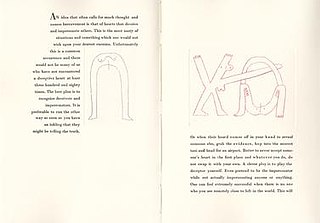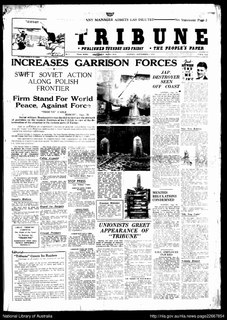
A library catalog is a register of all bibliographic items found in a library or group of libraries, such as a network of libraries at several locations. A bibliographic item can be any information entity that is considered library material, or a group of library materials, or linked from the catalog as far as it is relevant to the catalog and to the users (patrons) of the library.

The National Library of Australia (NLA) is the largest reference library in Australia, responsible under the terms of the National Library Act for "maintaining and developing a national collection of library material, including a comprehensive collection of library material relating to Australia and the Australian people." In 2012–13, the National Library collection comprised 6,496,772 items, and an additional 15,506 metres (50,873 ft) of manuscript material. It is located in Parkes, Canberra, ACT.
Peter Goodall is an Australian academic and author. In the mid-2000s he was Acting Dean of Humanities at Macquarie University in the absence of Dean Christina Slade. His substantive position was Deputy Dean of Humanities and Acting Head of the Politics and International Relations Department. By 2009 he had transferred to the University of Southern Queensland, Toowoomba campus where he was Dean of the Faculty of Arts.

In library and information science, cataloguing (UK) or cataloging (US) is the process of creating metadata representing information resources, such as books, sound recordings, moving images, etc. Cataloging provides information such as creator names, titles, and subject terms that describe resources, typically through the creation of bibliographic records. The records serve as surrogates for the stored information resources. Since the 1970s these metadata are in machine-readable form and are indexed by information retrieval tools, such as bibliographic databases or search engines. While typically the cataloging process results in the production of library catalogs, it also produces other types of discovery tools for documents and collections.
The J S Battye Library is an arm of the State Library of Western Australia. It stores much of the state's historical records and original publications including books, newspapers, periodicals, maps, and ephemera, as well as oral history tapes, photographs and artworks, films and video, and non-government records which are kept in the library's Private Archives collection. The library provides a range of services, including reference, copying, and genealogical services, as well as consultancy and reader education.
A bibliographic database is a database of bibliographic records, an organized digital collection of references to published literature, including journal and newspaper articles, conference proceedings, reports, government and legal publications, patents, books, etc. In contrast to library catalogue entries, a large proportion of the bibliographic records in bibliographic databases describe articles, conference papers, etc., rather than complete monographs, and they generally contain very rich subject descriptions in the form of keywords, subject classification terms, or abstracts.
The South West Book - A Tasmanian Wilderness is a book published by the Australian Conservation Foundation in 1978 during concern following the damming of Lake Pedder in Tasmania.

Newcastle Boys' High School was a government-funded single-sex selective high school, located in Waratah, a suburb of Newcastle, New South Wales, Australia. The school was active between 1929 and 1976, after which time it became a co-educational non-selective school.

Trove is an Australian online library database aggregator; a free faceted-search engine hosted by the National Library of Australia, in partnership with content providers including members of the National & State Libraries Australasia. It is one of the most well-respected and accessed GLAM services in Australia, with over 70,000 daily users.
International Bibliography of Periodical Literature covers the academic journal literature in the humanities, social sciences, and related disciplines. Coverage includes journals from 40 countries and in more than 40 languages. Subject indexing is based on the Subject Headings Authority File (Schlagwortnormdatei) and Name Authority File (Personennamendatei) published by the German National Library. The file size is over 3.3 million records from over 11,000 journals, with 120,000 records added annually..
The Kimberley Echo is a Kununurra, Western Australia based community newspaper.

Finlay Press is the name of an independent private press founded by Ingeborg Hansen and Phil Day (artist). It began production in Goulburn, NSW, Australia in 1997. In 2001 the press moved to Braidwood, New South Wales, Australia, where it printed its final publication in 2009.

Australian Town and Country Journal was a weekly English language broadsheet newspaper published in Sydney, New South Wales, from 1870 to 1919. The paper was founded by Samuel Bennett with his intention for it to be "valuable to everybody for its great amount of useful and reliable information".
John F Mazzaferro is a published American author on telecommunications subjects, specifically fiber optics and networking.
The Parliamentary Library of Australia is the library of the Parliament of Australia, administered by its Department of Parliamentary Services. It provides library services to elected officials, namely members of the Senate and House of Representatives, as well as their staff, parliamentary committees, the Governor-General of Australia, and the staff of parliamentary departments.

Tribune was the official newspaper of the Communist Party of Australia. It was published by the Central Committee of the Communist Party of Australia from 1939 to 1991. Initially it was subtitled as Tribune: The People's Paper. It was also published as the Qld Guardian, Guardian (Melbourne), Forward (Sydney). It had previously been published as The Australian Communist, (1920-1921) The Communist, (1921-1923) and the Workers' Weekly (1923-1939).
Schools Catalogue Information Service (SCIS) creates and distributes metadata for English-language resources used in K-12 schools, primarily for integration with integrated library systems. As of 2016, over 94% of Australian K-12 schools subscribed to SCIS, over 55% of New Zealand schools, and schools from 25 other nations.
Tourism Tasmania is the authority of the Government of Tasmania for dealing with tourism.